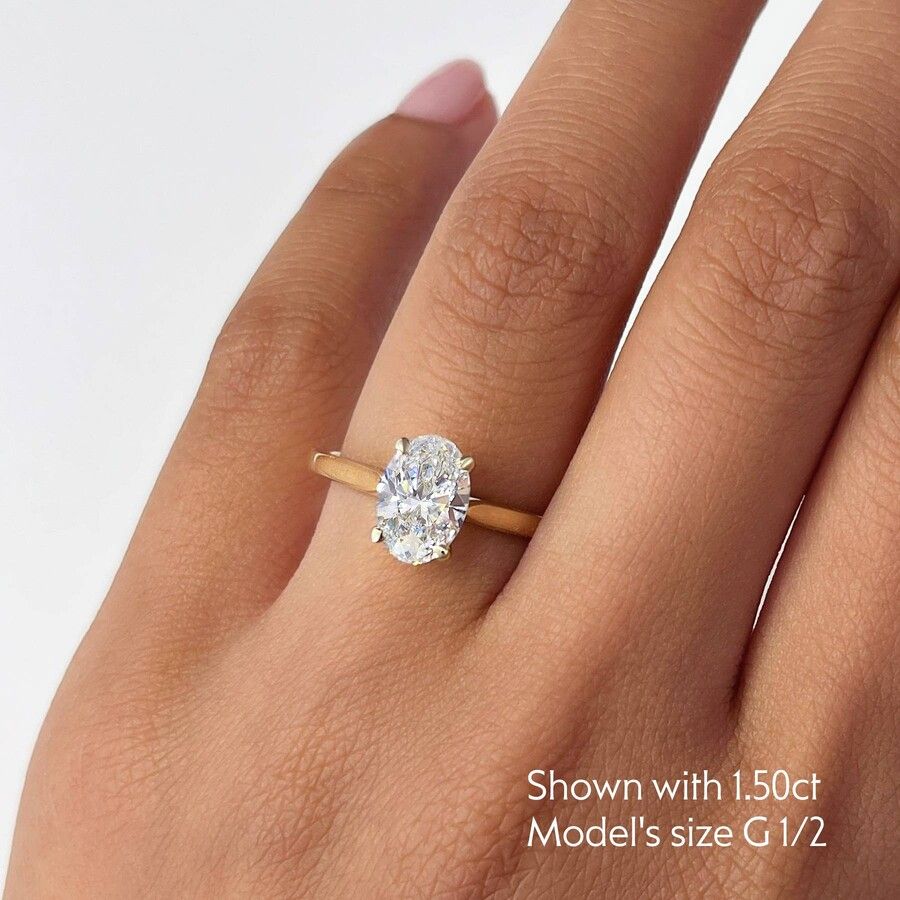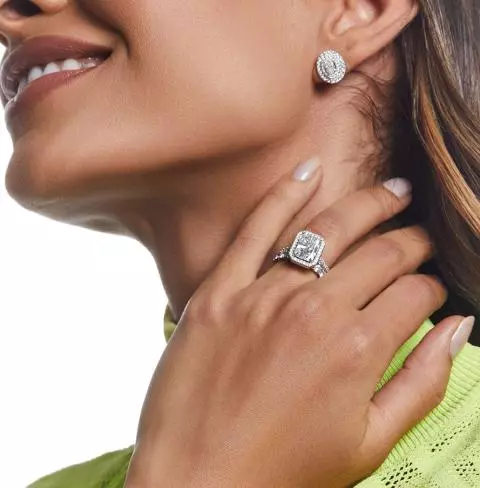The Meaning Behind Rings: What Engagement Rings Represent in Love
Engagement rings act as even more than simple fashion jewelry; they encapsulate the essence of love and dedication between partners. Each ring informs a story, influenced by historic traditions, the choice of gemstones, and design styles. As couples browse their special courses, the value of these accessories develops. The expedition of their symbolism exposes deeper significances and cultural subtleties, motivating one to consider what absolutely exists behind the selection of an interaction ring.
The Historical Relevance of Engagement Rings
Throughout history, countless societies have made use of Engagement rings as icons of commitment and love. Dating back to ancient Rome, the practice began with straightforward iron bands, standing for toughness and permanence. As cultures developed, so did the materials used; silver and gold became popular among the upscale, symbolizing wide range and standing. In the Center Ages, Engagement rings were commonly decorated with gemstones, thought to possess protective powers and bring good fortune to the union. By the 15th century, the diamond arised as the favored option, many thanks partially to Archduke Maximilian of Austria, who gifted one to Mary of Wine red, establishing a lasting fad. Different cultures have likewise instilled their one-of-a-kind customizeds into the method, with some including symbolic designs like knots or intertwined bands. On the whole, Engagement rings have actually gone beyond simple adornment, embodying deep cultural relevance and an assurance of integrity throughout generations.
The Definition of Various Gems
The appeal of gemstones extends past their aesthetic appeal, as each stone lugs its very own distinct symbolism and significance. Rubies, often the standard choice for Engagement rings, signify everlasting love and toughness. Their unmatched solidity shows a bond that endures in spite of difficulties. Emeralds, with their rich eco-friendly color, symbolize hope, revival, and development, making them a purposeful choice for pairs looking for to indicate a thriving partnership. Sapphires, usually blue, stand for knowledge and loyalty, capturing the essence of count on a partnership. Rubies, recognized for their vibrant red color, represent interest and desire, perfect for pairs who desire to express their zealous love. At the same time, much less conventional treasures like amethyst and aquamarine carry their own meanings; purple is linked to peace and equilibrium, while aquamarine signifies calm and quality. As a result, the choice of gems in an involvement ring can convey deep emotional and symbolic messages distinct to each couple.
The Importance of Ring Design and Style
The style and style of an involvement ring play an essential duty in mirroring a person's personal taste and values. In addition, the picked gems lug their own meaning, including layers of meaning to the ring. Social influences likewise shape the designs that are preferred, further highlighting the importance of style in Engagement rings.

Style Mirrors Personal Preference
An involvement ring works as a profound sign of dedication, and its design often mirrors the personal taste of the user. Each ring, whether sleek and modern, vintage-inspired, or delicately described, conveys the individual's distinct style and preferences. This individual touch not only boosts the ring's aesthetic allure yet also imbues it with deeper meaning. When choosing a design, pairs might think about variables such as steel kind, setting design, and overall craftsmanship, allowing the ring to resonate with their worths and identity. Inevitably, the Engagement ring comes to be a real depiction of the partnership, symbolizing both the love shared and the distinctive individualities of those included, making it a cherished item that stands the test of time.
Importance of Gemstones
Picking the right gemstone for an involvement ring includes an additional layer of significance to its layout. Each gems lugs one-of-a-kind definitions that can show the couple's partnership. Diamonds signify sustaining love and stamina, commonly picked for their radiance and longevity. Sapphires stand for loyalty and the aristocracy, making them an ideal choice for a companion that values dedication. Emeralds, with their vivid eco-friendly hue, symbolize growth and harmony, while rubies evoke interest and need. In addition, different stones, like opals or aquamarines, can reveal uniqueness and individual stories. The selected gemstone not only boosts the ring's visual charm however also functions as a tangible depiction of the emotional bond between companions, improving the overall significance of the Engagement.
Cultural Impacts on Designs
While personal choices play a substantial duty in selecting an interaction ring, cultural influences often shape the design and styles that couples gravitate toward. Various cultures have distinct practices and meaning associated with Engagement rings, influencing selections in metal, gems, and total style. In Western societies, diamond rings are a prevalent selection, symbolizing permanence and toughness. Alternatively, in some Eastern societies, colored gemstones, like rubies or sapphires, are preferred for their social significance and vibrant charm. In addition, modern fads accept non-traditional and one-of-a-kind styles, showing individualism while still valuing conventional values. Ultimately, the junction of social heritage and contemporary impacts causes a diverse variety of Engagement ring designs, enriching the definition behind each selection.
Social Variations in Engagement Ring Practices
Social variants in Engagement ring practices show the historical significance and local customizeds related to these signs of commitment. Different cultures have special methods pertaining to the choice of products, layouts, and also the timing of the ring presentation. Comprehending these differences offers understanding right into just how Engagement rings their explanation carry diverse meanings across societies.
Historical Importance of Rings
Engagement rings have long worked as powerful icons of commitment across numerous societies, each symbolizing distinct historical importance. In old Rome, rings made of iron signified toughness and permanence, while gold rings showed a greater social standing. In Egypt, rings were frequently made from braided reeds, representing eternity and a bond that transcends time. The custom of ruby Engagement rings arised in the 15th century, popularized by Archduke Maximilian of Austria, representing love and wealth. Meanwhile, in some African cultures, rings are crafted from local materials, emphasizing area and heritage. These varied methods highlight the ring's role as an universal symbol of love, commitment, and cultural identity, showcasing just how various cultures interpret this meaningful gesture throughout background.
Regional Variations in Customs
Around the world, diverse custom-mades form the value and presentation of Engagement rings, mirroring a tapestry of social values and customs. In numerous Western cultures, diamond rings symbolize love and dedication, frequently adhering to the proposal practice. On the other hand, some Eastern cultures choose easier bands, highlighting the act of Engagement over material value. In nations like Brazil, Engagement rings are used on the right hand, while couples change them to the left. In several African countries, the exchange of rings may not be traditional; rather, family members may exchange gifts signifying union. In addition, in particular Indigenous societies, distinct materials such as timber or rock may be used, showcasing the pair's connection to their heritage. Each variation encapsulates distinctive meanings and ideas bordering love and partnership.
The Function of Metal Choices in Importance
The choice of steel for an interaction ring brings substantial symbolic weight, influencing understandings of commitment and value (custom engagement rings). Gold, typically linked with wealth and security, represents the long-lasting nature of love. Yellow gold, with its traditional allure, mirrors heat and nostalgia, while white gold, appearing like pureness and modernity, talks with modern tastes. Platinum, known for its longevity, represents a strong, steady bond, signifying a partnership that can endure the test of time.On the other hand, increased gold conveys romance and interest, stimulating a sense of affection and heat. Different metals, such as titanium or tungsten, frequently signify stamina and resilience, attracting pairs that prioritize individuality and practicality. Eventually, the metal selected for an interaction ring not just mirrors individual style yet additionally communicates much deeper significances regarding the couple's worths, ambitions, and the nature of their commitment to each other
Personalization and Modification of Engagement Rings
Pairs significantly look for customization and modification in their Engagement rings to mirror their unique romance. This pattern allows people to move past standard designs and express their emotions and identities. Customization options consist of picking particular gems, crafting distinct settings, and including purposeful signs or inscriptions. For instance, some might pick birthstones or rocks that hold individual relevance, while others develop bespoke layouts that speak with shared experiences.Moreover, couples typically team up with jewelers to assure their rings encapsulate their journey together. This process not only improves the psychological value of the ring yet likewise fosters a feeling of ownership and satisfaction. As the focus shifts in the direction of personalized items, the Engagement ring transforms into greater than a plain symbol; it becomes a concrete depiction of a pair's dedication, love, and shared ambitions. Ultimately, customization enriches the narrative behind the ring, making it a valued antique for future generations.
The Development of Engagement Ring Trends
As Engagement ring fads have moved over the decades, they have actually mirrored broader social adjustments and personal values. In the very early 20th century, ruby jewelry became a sign of riches and condition, often showing typical gender duties. Post-World War II, the "diamond is for life" campaign solidified the ruby's location as the perfect Engagement stone, highlighting charming ideals.The 1970s saw an increase in vibrant colored gemstones, lining up with the counterculture motion and a desire for individuality. By the 1990s, couples began preferring special designs, often including vintage components. The brand-new millennium introduced a concentrate on moral sourcing, causing the appeal of lab-grown rubies and alternate materials.Today, personalization reigns supreme, with pairs choosing customized layouts that show their distinct stories. Engagement rings have actually developed from plain signs of dedication to meaningful expressions of love, uniqueness, and shared worths.
Frequently Asked Questions
What Is the Average Expense of an Engagement Ring?
The average expense of an involvement ring differs substantially, typically ranging from $5,000 to $10,000. Factors affecting this price consist of the high quality of the ruby, the ring's layout, and the seller's mark-up.
How Do I Pick the Right Dimension for an Engagement Ring?
Selecting the best dimension for an interaction ring involves determining the intended recipient's finger, thinking about seasonal adjustments in finger size, like it and consulting with a jewelry expert for exact sizing to assure convenience and proper fit. - diamond engagement rings
Can Engagement Rings Be Worn After Marital relationship?
Engagement rings can indeed be put on after marriage. Numerous people pick to wear them along with wedding bands, symbolizing their dedication. Others might favor to book them for special occasions, relying on personal preference and design.
What Do Various Ring Forms Signify?

Just how Do I Keep My Engagement Ring's Sparkle?
To preserve an engagement ring's luster, routine cleaning is essential. A gentle soap solution and soft towel can eliminate dirt. Additionally, expert cleaning and assessments every six months aid preserve the ring's luster and stability. The style and design of an engagement ring play an essential role in mirroring an individual's personal taste and worths. An interaction ring serves as an extensive sign of commitment, and its layout usually shows the personal preference of the wearer. Selecting the right gems for an interaction ring adds one more layer of value to its layout. While personal choices play a substantial function in picking an engagement ring, social impacts usually form the styles and layouts that pairs are attracted towards. In ancient Rome, rings made of iron represented strength and permanence, while gold rings indicated a greater social standing.